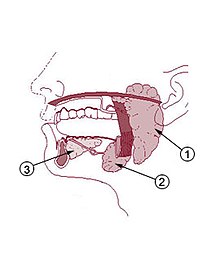Sublingual gland
The sublingual salivary gland or glandula sublingualis is one of the three large salivary glands in mammals that produce saliva . In humans , the sublingual salivary gland produces a mixed, but predominantly mucosal, secretion. In horses and predators it is also a mixed gland , in cloven-hoofed animals a purely mucous secretion is formed. As the name suggests, the gland is below the tongue .
structure
The sublingual salivary gland is divided into two departments.
Glandula sublingualis major
The major sublingual gland (called monostomatic sublingual gland in animals ) is a compact set of glands with a common duct ( major sublingual duct ). This opens together with that of the mandibular salivary gland on the starvation wart ( Caruncula sublingualis ), a small papilla on the side of the tongue . In horses , the compact department of the sublingual salivary gland is missing.
Glandulae sublinguales minores
The glandulae sublinguales minores , known in animals as the glandula sublingualis polystomatica , are scattered smaller bundles of glands . They have numerous ducts that open into the floor of the oral cavity on the side of the tongue .
Innervation
The sublingual salivary gland is innervated by the vegetative nervous system . The parasympathetic nerve fibers come from the chorda tympani , a branch of the seventh cranial nerve ( facial nerve ). These fibers join the lingual nerve and thus reach the submandibular ganglion (referred to as the mandibular ganglion in animals ), where they are switched. The postganglionic fibers then pull to the sublingual gland and also innervate the mandibular salivary gland.
Diseases
The obstruction of the duct can cause a blister-like protrusion of the oral cavity mucosa ( ranula ).
literature
- Franz-Viktor Salomon: oral cavity, cavum oris. In: Franz-Viktor Salomon u. a. (Ed.): Anatomy for veterinary medicine . 2nd ext. Edition. Enke-Verlag, Stuttgart 2008, ISBN 978-3-8304-1075-1 , pp. 239-264.
Individual evidence
- ^ Reiss, Michael: Specialist knowledge of ENT medicine . Springer Medizin Verlag, Heidelberg 2009, ISBN 978-3-540-89440-7 , p. 521 .

